When you use keyword clustering, you ensure your article ranks for multiple keywords other than the primary keyword.
Multiple keyword ranking means more organic traffic. And we all know what more traffic means—more opportunity for conversions.
So, how to do keyword clustering? I’ve discussed it in depth in this article.
In this article, you’ll get:
- The benefits of keyword clustering
- The steps needed to build keyword clusters
- ChatGPT prompts for grouping keywords
- Advanced cases for keyword clustering

What Is Keyword Clustering
In simple terms, keyword clustering is optimizing one article by grouping similar keywords that have a similar search intent, relevance, and semantic meaning.
Consider the example of a recent blog post I published. Though the target keyword is “blog traffic for beginners,” it’s also ranking for semantic keywords like “blog traffic tips,” “grow blog traffic,” “how to increase blog traffic,” etc.
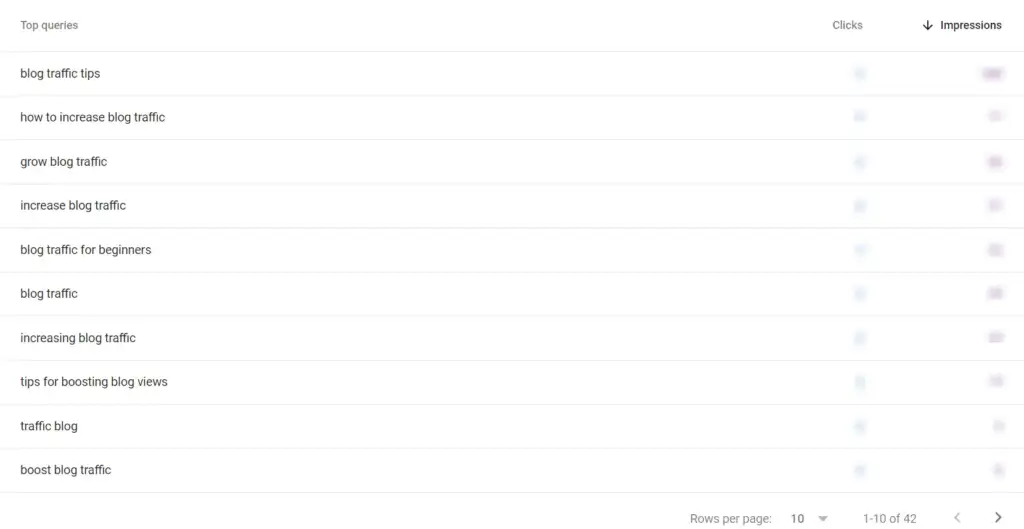
If you look at the semantic meaning and relevance of these keywords, they all have a similar search intent. So, it’s best to group them all in one blog post. And that’s keyword clustering. Here’s a guide on semantic search and how to use it.
How Does Keyword Clustering Help
Now, let’s look at how you can cluster the keywords you’ll use in your content:
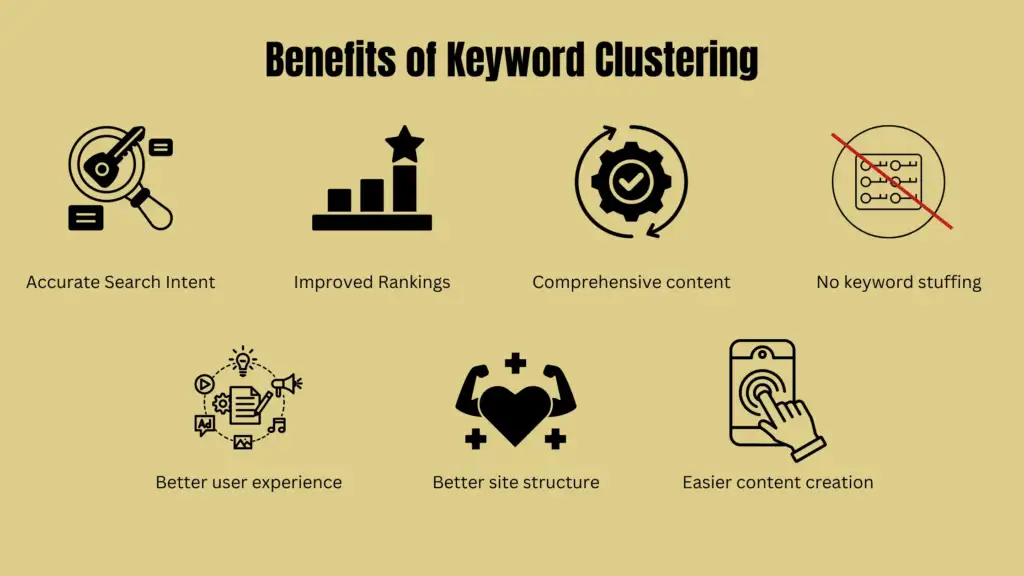
- Accurate Search Intent: Finding keywords to create clusters starts with SERP analysis. Only those keywords that have similar search intent are good to use. This process helps you to closely analyze the search intent and meet it entirely in the blog post. Multiple keywords you use help solve every query your target audience has.
- Improved Rankings: What do the rankings depend the most on? Search intent, of course. So, once you have nailed the search intent, you can automatically expect increased rankings. Also, not only for one keyword but more depending on the keyword cluster you create.
- Comprehensive content: One thing that search engines and audiences hate equally is shallow content. Gone are those days when you can rank with a 500-word blog post. But keyword clustering helps you create comprehensive content by creating outlines that answer all possible questions from your audience.
- No keyword stuffing: You already know keyword stuffing is a big no-no. You can include keywords naturally using semantic variations, which also helps you avoid repetitive content.
- Better user experience: An all-around content piece makes users return for more and truly engage with your website. It improves user experience and sends positive UX signals about your site to Google.
- Better site structure: The more detailed content you create, the higher your chance of internal linking. It enhances the site structure by telling search engines how you’ve interlinked content that builds authority.
- Easier content creation: Better and more detailed outlines make creating content easier. It becomes easy to create comprehensive content briefs so your writers know precisely what you want.
| Suggested reading: How to learn SEO content writing
How To Cluster Keywords For Multiple Ranking Opportunities
Now that you know all the benefits of using keyword clustering, let’s start with what you came here for—how to cluster keywords correctly.
1. Build a list of keyword ideas
Start with keyword research to list all the keywords you’ll use. Use keyword research tools like Semrush and Ahrefs to find keywords based on topics.
You can use your seed keywords to generate a list of rankable keywords, which you can later filter out using conditions like:
- Keyword difficulty
- Monthly search volume
- Long-tail vs short-tail keywords
Note: For quick ranking, select keywords with low difficulty. Also, aim to find more long-tail keywords, as they have a very specific and high search intent and hence low competition.
Another way to build a list of keywords is to use Google Keyword Planner (GKP) and Google Search. GKP lets you find keywords based on two inputs: the seed keywords and website links. Test these keywords on Google search to find if their search intent is relevant to your blogging goals.
Save the keywords in an Excel sheet with information like volume, keyword difficulty, and search intent. You can also go a step further and add the category of these keywords, as it’ll help in the next step of clustering them.
Here’s an example of all the related keywords I generated from GKP for the seed keyword “baby car seat.”

2. Cluster them with a tool
If you’re using Ahrefs or Semrush, clustering keywords is simple and automated. Both tools offer filter options to filter out keywords with a certain word in the phrase.
Group similar keywords and add a tag to them to specify the category.
Other keyword clustering tools include Keywords Insights, SEO Scout, and SE Ranking. These tools do automated keyword clustering for you, which is primarily based on the search intent.
Sometimes, you may need to manually group the keywords further because automated clustering by tools can go wrong. If you’re using Excel sheets, you might need to use some formulae to determine the percentage keyword difficulty or average volume. Use free AI tools that help generate Excel formulae, so you save time.
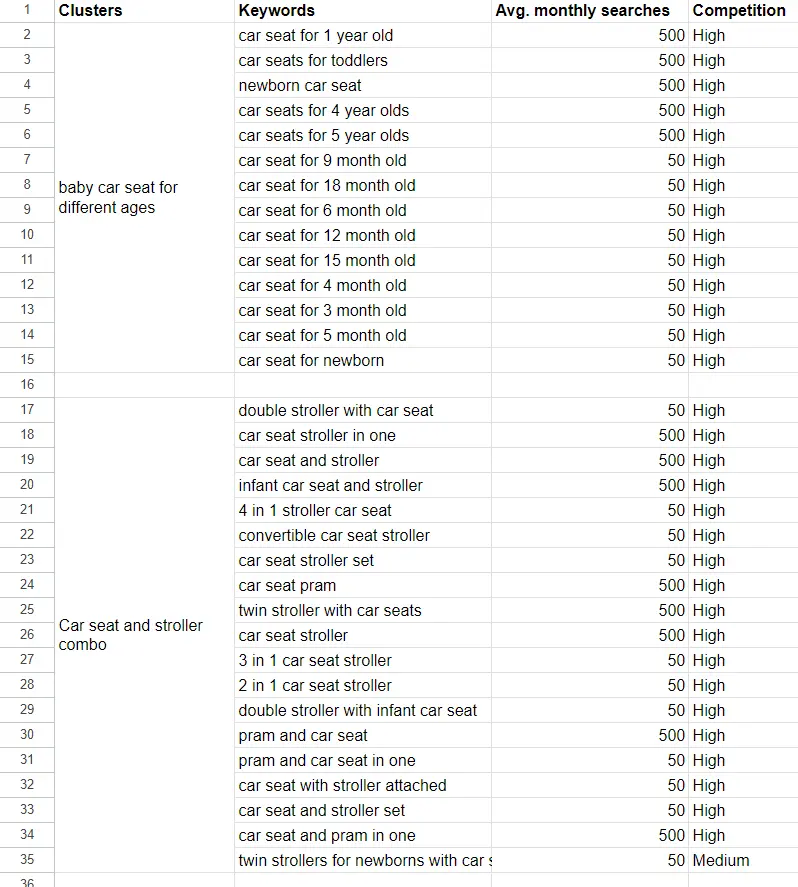
But to manually group keywords, you need first to know what makes an effective cluster.
When to add keywords in a cluster and when to avoid it:
1. Search Intent:
The first thing to consider is the search intent. Since you’re targeting these keywords for a single blog post, you need to have a single search intent.
Determine whether the selected keyword has:
Informational intent: Users seek to learn more about a topic or find an answer to a question.
Navigational intent: Users intend to find a specific website or page.
Commercial intent: Users are researching products or services to purchase in the future.
Transactional intent: Users are ready to complete a purchase or perform a specific online action.
For example, the keyword “car seat safety” has an informational intent, but “car seat safety ratings” has a commercial intent.
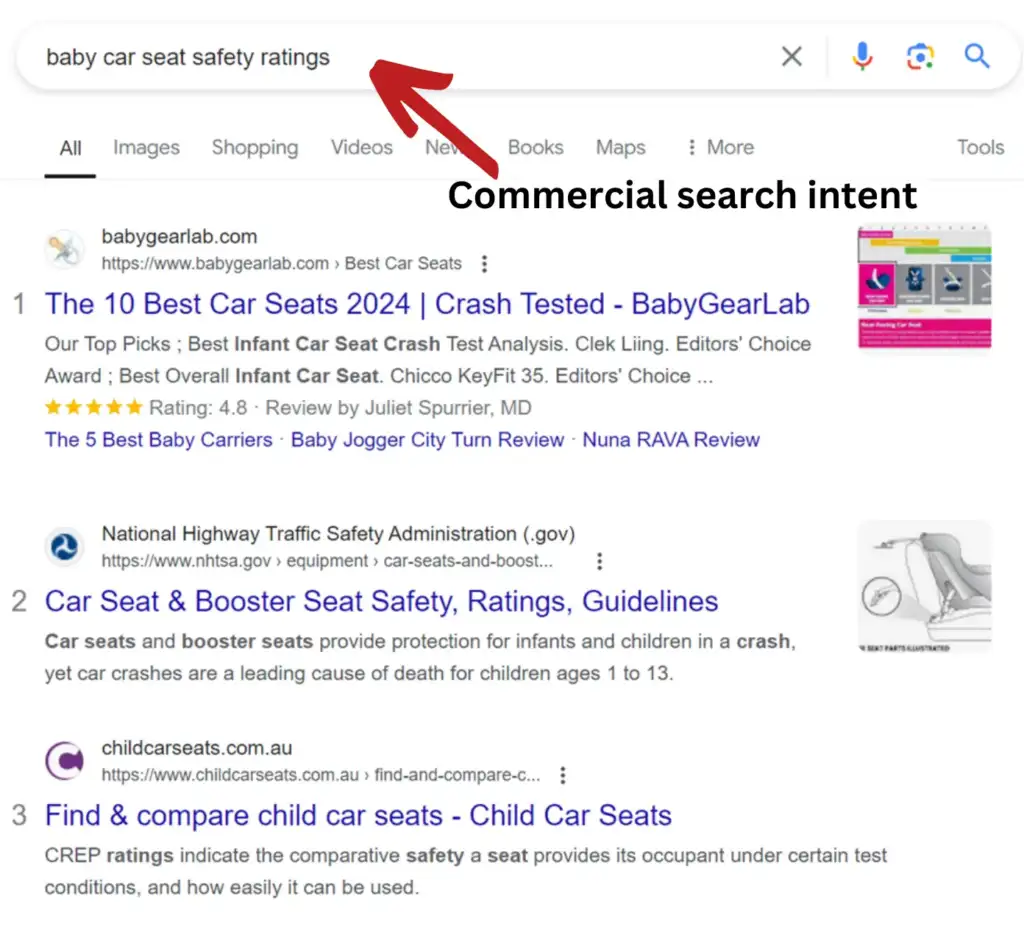
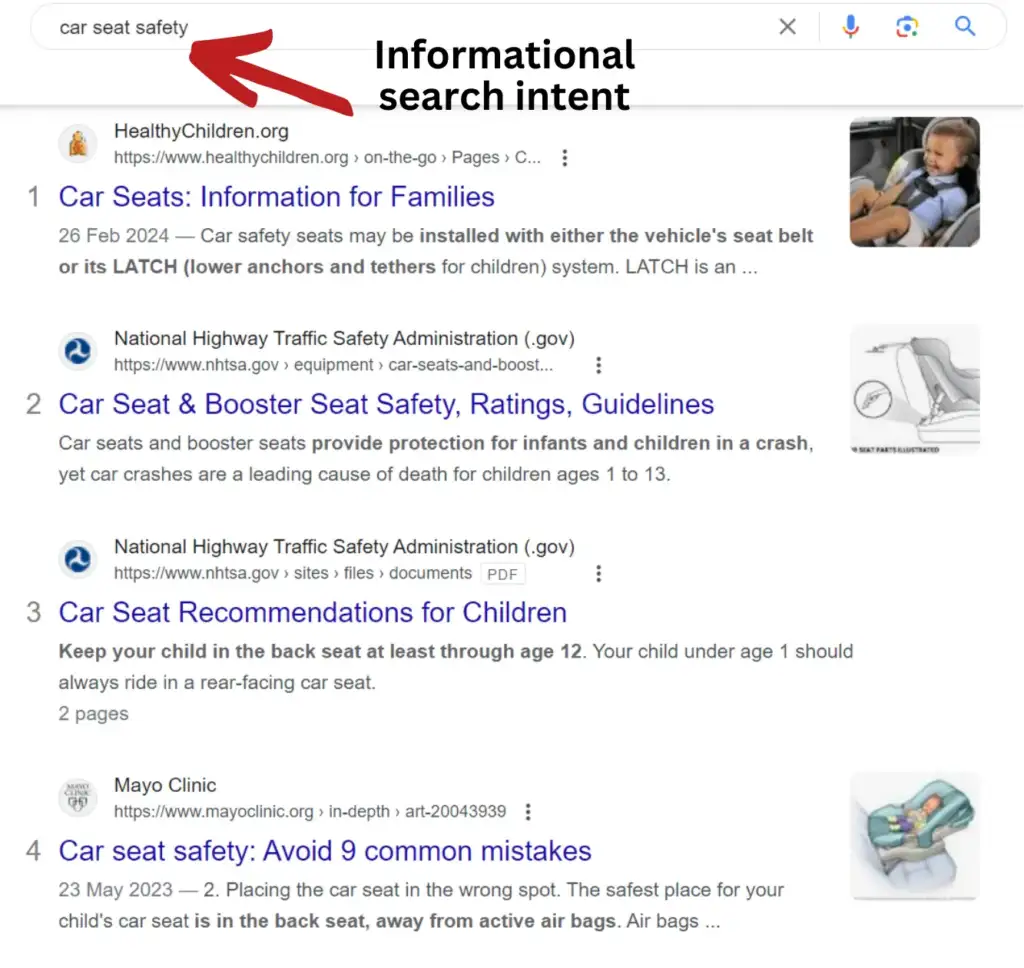
You can’t group these two together, but car seat safety ratings can be a useful addition to the best baby car seats blog post.
2. SERP results:
Then, you need to see the SERP because SERP answers most of your questions. If the search intent is the same, you’ll have at least the same 3-4 articles ranking for different keywords.
You need to fix a number acceptable for the same articles ranking for different keywords. For example, if you set the number as 3 and two keywords have 3 articles ranking for both of them, you’ll add those keywords to the cluster.
Here’s an example where you have four same articles ranking for two different keywords.
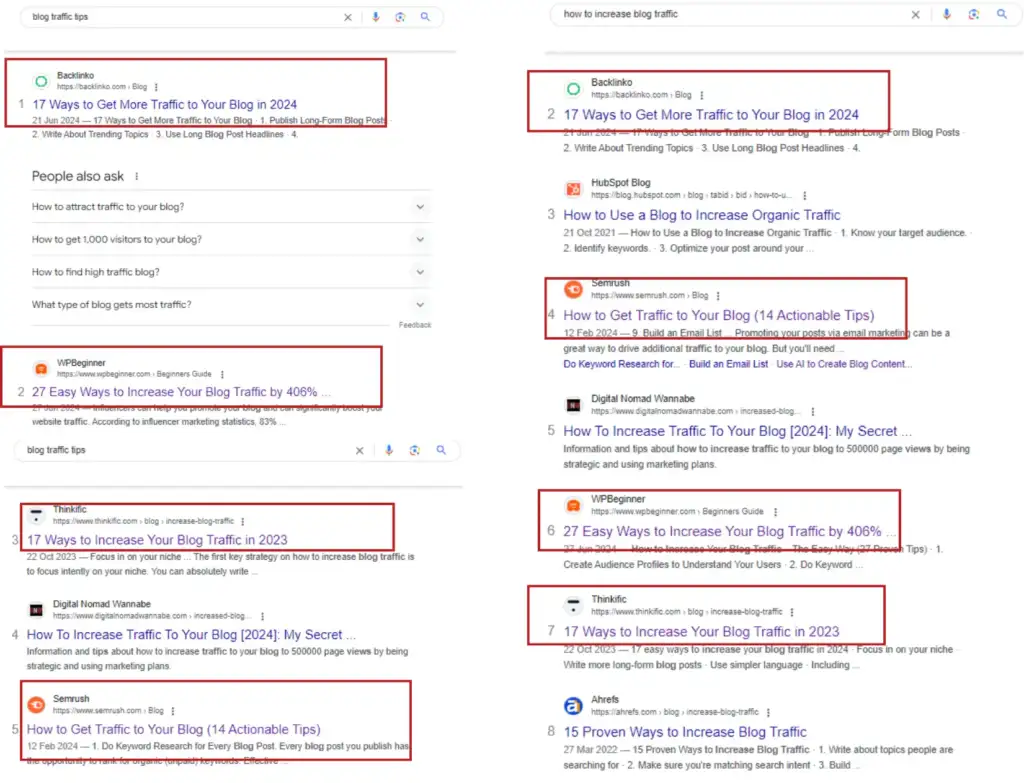
3. Keyword Cannibalization:
If you find more than one page on your site targeting one keyword or repeating the same content, it’s called keyword cannibalization. If there’s keyword cannibalization on your site, it’s a sign you should optimize these pages to club them together. If you find such keywords, create a cluster and only publish content for the target keyword.
4. Topic/semantics
When clustering keywords, it’s important to consider the semantic relationship between terms. Keywords that share similar meanings or cover closely related subtopics should be grouped together. It helps create comprehensive content that addresses a topic thoroughly.
For example: baby car seats, infant car seats, and car seat strollers could be clustered due to their semantic similarity.
5. Difficulty and search volume
Consider the keyword difficulty (how hard it is to rank for) and search volume when clustering. You might want to group keywords with similar difficulty levels to create content strategies tailored to your site’s authority. High-volume keywords can be paired with related lower-volume long-tail keywords to capture a broader range of search traffic while still maintaining topical focus.
6. Competitor rankings
Analyze which competitors are ranking for the keywords you’re considering clustering. If you see the same competitors consistently ranking for a set of keywords, it’s a good indicator that those terms can be effectively targeted with a single piece of content. This analysis can also reveal content gaps or opportunities where your competitors might miss certain keyword combinations within a topic cluster.
| Suggested reading: SEO mistakes that lead to the downfall of your website
3. Determine The Primary Keyword Of Your Keyword Cluster
Now, this is a critical part because though you target multiple keywords, your blog post will only have one primary keyword.
To determine which keyword to make primary, consider:
- Search volume: Choose the keyword with the highest search volume while being in the right scale of keyword competitiveness. This will ensure you only target the low-hanging fruit.
- Content relevance: Select a keyword that best encapsulates your planned content’s main topic or theme.
- Competitive difficulty: Balance search volume with the difficulty of ranking. Sometimes a slightly lower volume keyword with less competition might be a better target.
- Conversion potential: Conversions are a priority. You need to target the keyword most likely to attract users who are ready to take desired actions on your site. You can do this by understanding your audience’s most commonly used keyword. Using that keyword will naturally prompt your users to click.
- Long-tail vs. short-tail: While short-tail keywords often have higher volume, long-tail keywords can be more specific and easier to rank for. Use long-tail keywords as they also have highly specific search intents.
- Current rankings: If you’re already ranking well for a particular keyword in the cluster, choosing that as your target might be strategic.
- SERP features: Look at each keyword’s search engine results page (SERP) features. Target keywords with SERP features you can capture (e.g., featured snippets, image packs).
- Trend analysis: Use tools to check if certain keywords in your cluster are increasing in popularity.
- Semantic breadth: Choose a keyword that allows you to incorporate other related keywords from the cluster naturally.
4. Write Content
When all is taken care of with keywords, the next step is creating blog posts. You’ll either have existing posts that need optimization or new content briefs for entirely new posts.
Choosing a priority becomes essential. Optimizing already existing posts is easier and can bring results faster. So, focus first on updating the existing posts based on your keyword cluster.
Then, assign time to writing new blog posts that follow an outline aligned with the clusters.
5. Audit and analyze results
You can’t improve something you don’t audit. Analyzing whether your keyword clusters yield results is easy with Google Search Console.
Simply filter the impressions and clicks for your blog post using the “Page” filter. GSC will give you the keywords users search for before your post is shown on Google.
The more impressions the keywords in your clusters get, the better it’s performing.
You can also dig deep by adding the CTR (click-through rate) and Position filters.
| Suggested reading: How to earn through your SEO skills
Extra Step: Keyword Clustering Using Chatgpt
I know I’ve already listed the best keyword clustering tools, but it’s cool to know we can use AI, especially if you want to get started.
You can start from the beginning and ask ChatGPT to generate a list of related keywords for your seed keyword.
Here’s the prompt: “You’re an SEO with 10+ years of experience and excel at writing product reviews. You have the knack of creating keyword clusters that help blog posts rank faster, higher, and for multiple keywords. Generate a list of related keywords for [keyword]. Limit the keywords to 3 words each”
Here’s what the output looks like for this prompt:
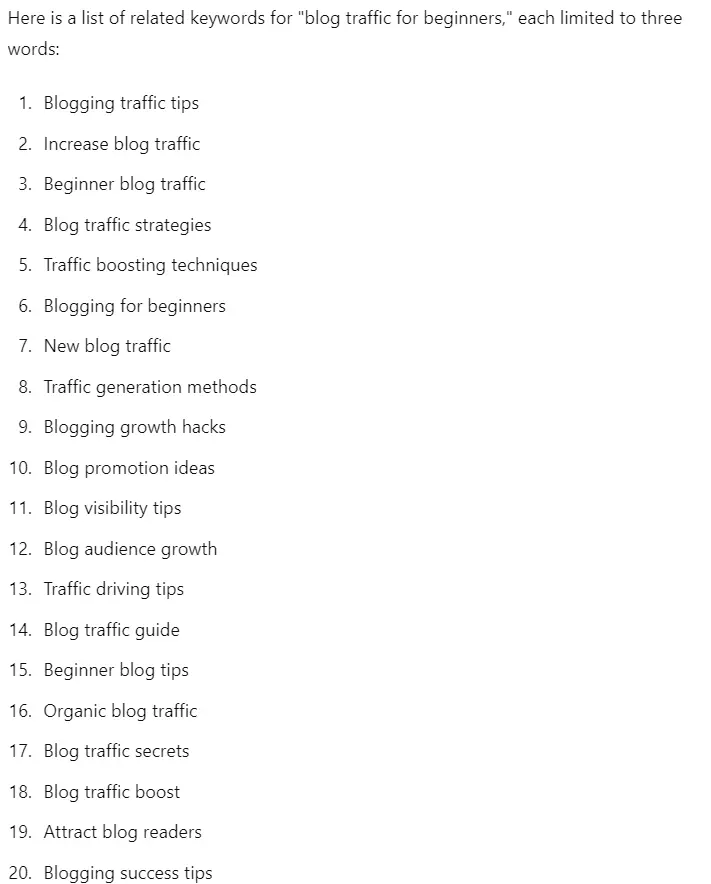
Then ask ChatGPT to group these keywords into groups of semantically similar keywords. You can also suggest the main keywords for each cluster.
Here’s the prompt: Group these keywords into clusters based on their semantic similarity: [keyword1], [keyword2],…..,[keyword n]
Here’s the output:

Now, you can Google these keywords to confirm their search intent, which is the most ideal way to go about it. Otherwise, you can also ask ChatGPT to specify the search intent for each keyword.
Note: It’s important that you confirm that the keywords ChatGPT shared are the right ones by finding their SERP results, as AI can sometimes generate wrong answers.
Advanced Tips On Grouping Keywords In Clusters
There are some cases where keyword clustering is quite challenging. Here are some of those common cases and how to approach keyword clustering for them:
- Multilingual SEO: It’s challenging to manage keyword clustering across multiple languages. Develop separate clusters for each language, ensuring cultural and linguistic nuances are considered.
- Dynamic Content Clustering: Grouping keywords for dynamic websites, like news portals or e-commerce sites, is time-consuming. Use advanced algorithms to automate keyword clustering based on real-time data and user behavior. Employ machine learning to optimize clusters as content and search trends evolve continuously.
- Handling Seasonal Keywords: It’s difficult to incorporate keywords that are seasonally relevant. Create temporal clusters that are activated during specific periods. Using past data, predict seasonal trends and then modify clusters appropriately.
- Local SEO Clustering: Develop clusters with local modifiers (e.g., “near me,” city names) and focus on local intent.
- Content Personalization: Use user segmentation to create tailored keyword clusters that match different audience personas. Implement personalization algorithms to serve relevant content dynamically based on user behavior.
| Suggested reading: How to generate revenue for service-based businesses using SEO
Final Thoughts
Now that you know what it takes to create keyword clusters, start optimizing your content to rank higher.
Remember, the key is to stay true to the user intent and only use those keywords that align well with the content’s requirements.
If you focus on answering user queries more than pleasing the search engines, you’ll sure see a rise in your rankings.
Need help with strategizing your blog content and SEO? Book a call with me!



